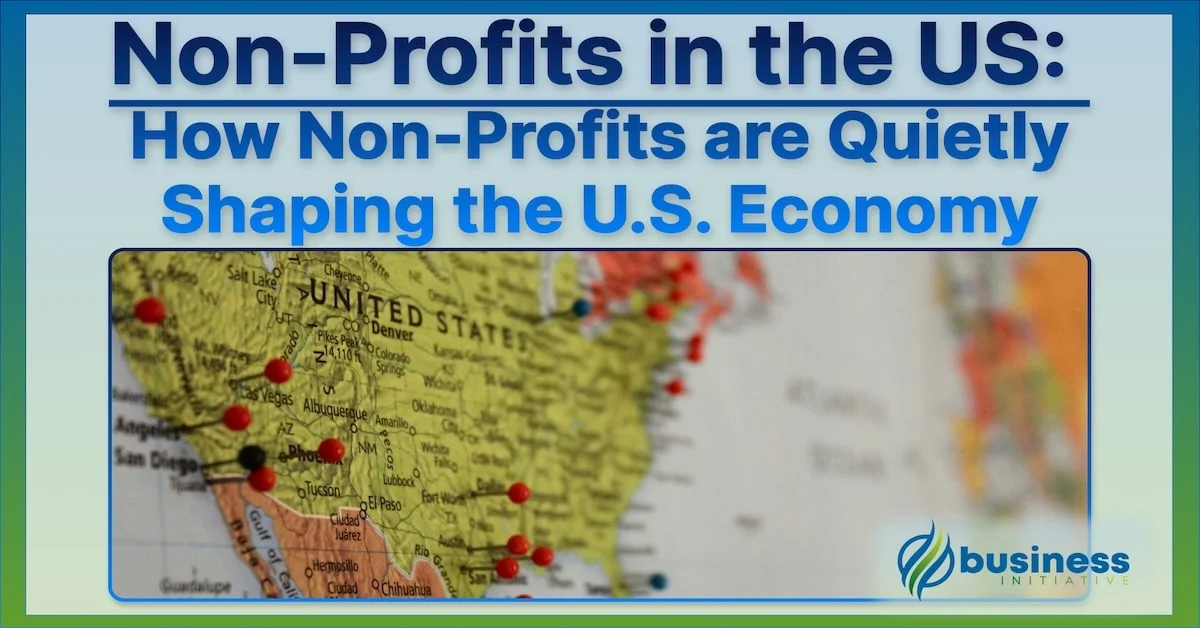Non-profit organizations are the backbone of many essential services in the United States.
From social services and education to healthcare and cultural institutions, these organizations fill gaps that neither government nor businesses address.
Non-profits play a pivotal role in shaping communities, supporting underrepresented groups, and driving social change.
Their contributions are often overlooked but are fundamental to the country’s well-being.
 Key Takeaways
Key Takeaways
- Non-profits are tax-exempt organizations that reinvest all earnings to advance social, educational, or charitable missions.
- The U.S. has over 2 million non-profits, contributing significantly to both societal needs and the economy.
- Non-profits employ 12.8 million people, representing nearly 10% of the U.S. private-sector workforce.
- Funding, staffing shortages, and compliance regulations are the biggest challenges non-profits face, especially during economic downturns.
- Growth opportunities for non-profits lie in digital fundraising, corporate partnerships, and adopting social entrepreneurship models.
This article takes a deep dive into the current state of non-profits in the U.S., exploring how many exist, their areas of impact, and why understanding their role matters now more than ever.
 Table of Contents
Table of Contents
What is a Non-Profit Organization?

A non-profit organization exists to serve a purpose beyond profit.
It operates to fulfill a mission, whether that’s providing social services, supporting education, offering healthcare, or fostering community development.
Unlike for-profit entities, non-profits do not distribute their earnings to shareholders or individuals.
Instead, any income supports their cause and growth.
One key difference is tax-exempt status.
Non-profits don’t pay federal income taxes as long as they comply with IRS regulations.
There are various types of non-profits, including charitable, religious, and educational organizations.
Many operate under the 501(c) tax designation.
For example, 501(c)(3) organizations focus on charitable, religious, or educational activities.
On the other hand, 501(c)(4) groups engage in advocacy or social welfare.
In fact, as of 2022, approximately 75,000 advocacy and social welfare 501(c)(4) organizations are registered in the U.S. according to Statista Research Department.
These organizations, large and small, are exempt from federal income tax, as highlighted by USAFacts.
How Many Non-Profit Organizations Are in the U.S.?

The number of non-profit organizations in the U.S. has been growing steadily for decades.
As of 2022, there were 1.97 million non-profits, and by 2023, this number rose to 2 million, highlighting the expanding role these organizations play in American society.
The majority of these, 1.48 million, fall under the 501(c)(3) designation, which includes charitable, educational, and religious organizations that enjoy tax-exempt status.
Number of Nonprofits in the United States
Non-profits have experienced consistent growth since 1998, when there were 1.16 million organizations.
According to data from Statista, this number increased to 1.80 million by 2017, then to 1.97 million in 2022.
The rise from 1.54 million in 2016 to 1.80 million in 2017 is especially notable and corresponds with an increased demand for community services and advocacy.
In 2022, U.S. non-profits also had a substantial economic impact, with total annual expenses exceeding $2.46 trillion.
Furthermore, advocacy and social welfare organizations registered under 501(c)(4) saw growth as well, reaching 75,000 in 2022.
Non-profits not only provide services but also contribute to employment.
According to the U.S. Bureau of Labor Statistics, over 300,000 non-profit establishments employed 12.8 million people in 2022, representing 9.9% of all private-sector jobs in the country.
Geographically, states like California, New York, and Texas lead in the number of non-profits due to their large populations and diverse economic environments that support these organizations.
This data highlights the critical role non-profits play in addressing societal challenges, supporting public welfare, and driving economic growth across the U.S.
Economic and Social Impact of Non-Profits

Economic influence of Non Profits
Non-profits make a massive contribution to the U.S. economy.
In 2017, the sector accounted for 10.2% of all private-sector jobs, with the majority of these jobs—66.7%—in healthcare and social assistance.
Education followed with 16.2% of non-profit employment.
The financial impact of non-profits is equally impressive.
In 2019, 501(c)(3) organizations generated $2.4 trillion in revenue, with 70.8% coming from program services like admissions, fees, and tuition.
Donations and grants accounted for 22.8% of their revenue.
Large non-profits such as Feeding America and the American Red Cross have significant financial influence.
In 2023, Feeding America received over $4 billion in private donations, making it the U.S. charity with the highest private donations.
Non-profits like hospitals, universities, and major charities support communities with essential services and relief efforts.
Social importance of Non Profit Organizations
Socially, non-profits are critical in addressing key societal needs.
They provide services to underserved populations, such as poverty relief, education, and healthcare access.
Faith-based organizations play an important role, with 16.8% of donations in 2021 going to these groups, more than any other non-profit subsector.
Non-profits also face challenges.
By 2024, nearly one-third of U.S. NGOs reported staffing shortages, with 5-14% of positions unfilled.
Despite this, 35% of non-profits raised pay and benefits in 2023 to address recruitment and retention issues.
This blend of economic strength and social good ensures that non-profits remain a vital part of American life, helping to build stronger, more equitable communities.
Challenges Facing Non-Profits

Non-profits face several critical challenges that threaten their ability to sustain operations and fulfill their missions.
Financial reliance on donations, grants, and fundraising often creates instability, especially during times of economic downturn.
The COVID-19 pandemic significantly impacted the sector, with 37% of non-profits experiencing a decrease in donations in 2020.
Smaller organizations, particularly those with annual budgets under $500,000, were hit the hardest, with 42% reporting reduced donations, compared to 29% of larger non-profits.
Another challenge is staffing.
35% of non-profits increased pay and benefits to address recruitment and retention issues in 2023.
Regulatory and compliance hurdles also add pressure.
Non-profits must carefully maintain their tax-exempt status under complex regulations, making compliance an ongoing challenge.
Furthermore, organizations led by people of color experienced higher rates of donation declines from 2015 to 2019—14% compared to 9% of those led by non-Hispanic whites, reflecting a gap in funding equality.
Economic instability only compounds these issues, making it harder for non-profits to maintain a steady stream of funding and resources essential to their operations.
Opportunities for Growth in the Non-Profit Sector

Non-profits are poised for significant growth through strategic use of technology and partnerships.
Digital fundraising platforms, like GoFundMe and Classy, along with social media tools, enable non-profits to expand their reach and engage new donors.
In fact, 75% of non-profits consider individual donations essential or very important to their operations.
Partnerships with governments and corporations provide another avenue for growth, offering grants and increased funding.
The rise of social entrepreneurship presents new models of sustainability by blending business strategies with social missions.
This innovative approach helps non-profits become more resilient in fluctuating economic conditions.
Diversity is also improving within non-profit leadership.
70% of non-profit boards now include at least one person of color, although only 21% of executive directors identify as people of color.
Expanding this leadership could drive more inclusive growth.
Technology also allows non-profits to extend their global reach.
International collaborations and digital platforms help organizations address global challenges, increasing their impact beyond borders.
FAQs - Frequently Asked Questions About Non-Profits in the United States

What is a non-profit organization?
A non-profit serves a mission rather than making a profit.
It reinvests income into its mission instead of distributing profits.
Learn More...
A non-profit organization is designed to advance a social cause or provide public benefit.
Unlike for-profit businesses, they reinvest any income back into their operations to further their mission, such as education, healthcare, or social services.
Common types include 501(c)(3) charitable organizations and 501(c)(4) social welfare groups, both of which are tax-exempt.
How many non-profit organizations are in the U.S.?
As of 2023, there are about 2 million non-profits in the U.S.
Learn More...
The U.S. is home to a rapidly growing non-profit sector, with 2 million registered organizations as of 2023.
These include 1.48 million 501(c)(3) organizations, which focus on charitable, religious, or educational activities.
This growth highlights the expanding role non-profits play in sectors like healthcare, education, and community services.
Why are non-profits important to the U.S. economy?
Non-profits contribute significantly to jobs and services.
They account for nearly 10% of all private-sector jobs.
Learn More...
Non-profits play a critical role in the economy, employing over 12.8 million people, which represents 9.9% of all private-sector jobs in the U.S.
In 2022, non-profits had a substantial economic impact, with expenses exceeding $2.46 trillion.
Their influence extends to essential services in healthcare, education, and social welfare, which benefit millions of people annually.
What challenges do non-profit organizations face?
Non-profits often struggle with funding and staffing shortages.
Learn More...
Non-profits rely heavily on donations, grants, and fundraising, making them vulnerable to economic downturns.
The COVID-19 pandemic caused a drop in donations for 37% of non-profits in 2020, with smaller organizations hit the hardest.
Additionally, nearly one-third of NGOs report staffing shortages, forcing many to raise salaries to attract and retain talent.
What are the different types of non-profit organizations?
The main types are 501(c)(3) and 501(c)(4) organizations.
Learn More...
501(c)(3) organizations are dedicated to charitable, religious, or educational purposes and are the most common type of non-profit, making up about 1.48 million of the U.S. total.
501(c)(4) organizations focus on social welfare and advocacy, and they can engage in political activities, with 75,000 registered in 2022.
Both are tax-exempt, though they serve different purposes and have distinct regulations.
How do non-profit organizations raise money?
They raise funds through donations, grants, and program services.
Learn More...
Non-profits rely on various sources of revenue, including donations from individuals, foundations, and corporations, which make up 22.8% of their income.
The majority of revenue—70.8%—comes from program services such as tuition fees, admissions, and other service-related fees.
Online fundraising, such as through platforms like GoFundMe, is becoming an increasingly important tool for non-profits to reach a broader donor base.
How do non-profits benefit society?
Non-profits fill gaps in public services and advocate for underserved groups.
Learn More...
Non-profits address critical societal needs by providing services that government and businesses often cannot, such as poverty relief, education, and healthcare.
They are essential in supporting underserved populations, and in 2021, 16.8% of all charitable donations went to faith-based organizations.
By driving social change and advocating for equity, non-profits help build stronger communities and foster societal well-being.
What are the opportunities for growth in the non-profit sector?
Digital fundraising and partnerships offer major growth opportunities.
Learn More...
Non-profits are increasingly leveraging digital platforms like GoFundMe and Classy to expand their reach and increase donations.
Partnerships with corporations and governments also provide valuable resources through grants and funding.
Social entrepreneurship, blending business strategies with social missions, is another emerging model that helps non-profits remain sustainable in the face of economic challenges.
In Summary…
The U.S. is home to over 2 million non-profits, each playing a crucial role in addressing societal challenges like poverty, education, and healthcare.
These organizations provide essential services while contributing significantly to the economy.
However, non-profits face financial instability, staffing shortages, and regulatory hurdles.
Yet, opportunities for growth abound through digital fundraising, corporate partnerships, and social entrepreneurship.
By understanding the non-profit landscape, you can take action—whether through donations, volunteering, or launching your own initiative.
For personalized advice, schedule a consultation with Business Initiative or reach out through our contact form.
Explore more by subscribing to The Initiative Newsletter or following us on X for the latest insights into non-profit growth and much more…
Sources & Additional Information
- USAFacts. (2022). How many nonprofits are there in the US? USAFacts
- Statista Research Department. (2022). Nonprofit organizations in the US - Statistics & Facts Statista Research Department
- Urban Institute. (2021). Nonprofit Trends and Impacts 2021 Urban Institute
- U.S. Bureau of Labor Statistics. (2022). Nonprofit Employment and Wages U.S. Bureau of Labor Statistics
- National Center for Charitable Statistics (NCCS). National Center for Charitable Statistics (NCCS)
- IRS. Tax Exempt and Government Entities - Charities and Nonprofits IRS
- GuideStar. Nonprofit Reports and Forms 990 for Donors, Grantmakers, and Businesses GuideStar


